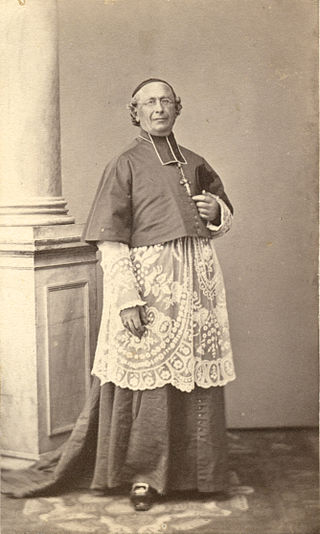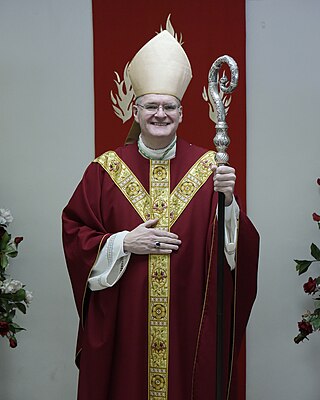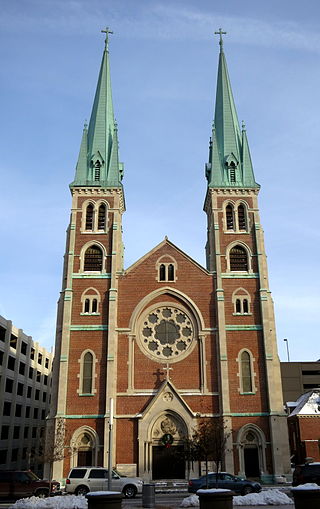Related Research Articles

Anne Thérèse Guérin, designated by the Vatican as Saint Theodora, was a French-American saint and the foundress of the Sisters of Providence of Saint Mary-of-the-Woods, a congregation of Catholic sisters at Saint Mary-of-the-Woods, Indiana. Pope John Paul II beatified Guérin on 25 October 1998, and Pope Benedict XVI canonized her a saint of the Catholic Church on 15 October 2006. Mother Guérin's feast day is 3 October, although some calendars list it in the Roman Martyrology as 14 May, her day of death.

The Diocese of Fort Wayne–South Bend is a Latin Church ecclesiastical territory, or diocese, of the Catholic Church in north-central and northeastern Indiana in the United States.

The Archdiocese of Indianapolis is a Latin Church diocese of the Catholic Church in Indiana in the United States.

Benedict Joseph Flaget was a French-born Catholic prelate who served as Bishop of Bardstown from 1808 to 1839. When the see was transferred to Louisville in 1839, he became Bishop of Louisville, remaining in the post from 1839 to 1850. He was a member of the Sulpicians.

Silas Francis Marean Chatard was an American Catholic prelate who served as Bishop of Indianapolis from 1898 to 1918.

The Diocese of Evansville is a Latin Church diocese of the Catholic Church in Southwestern Indiana in the United States.

Simon William Gabriel Bruté de Rémur was a French missionary in the United States and the first bishop of the Diocese of Vincennes, Indiana. President John Quincy Adams called Bruté "the most learned man of his day in America."

John Stephen Bazin was the third Roman Catholic Bishop of Vincennes.
Anthony Deydier, was a French priest, missionary and teacher.

Célestin René Laurent Guynemer de la Hailandière was a French prelate of the Roman Catholic Church. He served as Bishop of Vincennes from 1839 to 1847. He is perhaps best known for donating the land for the establishment of the University of Notre Dame.
Jacques-Maurice des Landes d’Aussac de Saint Palais was an American prelate of the Roman Catholic Church. He served as the fourth Bishop of Vincennes, from 1848 until his death.
Joseph Chartrand was an American prelate of the Catholic Church. He was the 6th Bishop of Indianapolis, serving from 1918 until his death in 1933.

Augustus Marie Martin was a French-born prelate of the Roman Catholic Church. He served as the first bishop of the Diocese of Natchitoches in Louisiana from 1853 until 1875.
Emmanuel Boleslaus Ledvina was an American prelate of the Roman Catholic Church. He served as bishop of the Diocese of Corpus Christi in Texas from 1921 to 1949.

Herman Joseph Alerding was a German-born American prelate of the Roman Catholic Church. He served as bishop of the Diocese of Fort Wayne in Indiana from 1900 until his death in 1924.

Joseph Mark Siegel is an American prelate of the Catholic Church who has served as bishop of the Diocese of Evansville in Indiana since 2017. He previously served as auxiliary bishop of the Diocese of Joliet in Illinois from 2009 to 2017.

The St. Francis Xavier Cathedral is a historic Catholic church in Vincennes, Indiana, under the Diocese of Evansville. Named for Francis Xavier, the 16th-century Jesuit missionary, it is located opposite George Rogers Clark National Historical Park at 205 Church Street, within the Vincennes Historic District.

Saints Peter and Paul Cathedral is a Roman Catholic cathedral located at Fourteenth and Meridian Streets in Indianapolis, Indiana, United States. It is the seat of the Archdiocese of Indianapolis, and of the Archbishop of Indianapolis, currently Archbishop Charles C. Thompson. Silas Chatard, the first Bishop of Indianapolis, established the cathedral parish in 1892, and named it after Saint Peter and Saint Paul, two apostles of Christ.

Saint John the Evangelist Catholic Church is a Catholic parish of the Archdiocese of Indianapolis in Indianapolis, Indiana, United States. The parish's origins date to 1837, when it was first named Holy Cross parish. In 1850 it was renamed Saint John the Evangelist parish, and is the oldest Catholic parish in the city and in Marion County, Indiana. Considered the mother of the Catholic parishes in Indianapolis, it played an important role in development of the Catholic Church in the city. Saint John's Church served as the pro-cathedral of the diocese from 1878 until 1906; its rectory served as the bishop's residence and chancery from 1878 until 1892. In 1900 the church served as the site of first episcopal consecration held in Indianapolis.

Bishop Simon Bruté College Seminary is a Catholic college seminary located in Indianapolis, Indiana, within the Archdiocese of Indianapolis. The seminary takes its name from Bishop Simon Bruté, first bishop of the Diocese of Vinncennes, who came to Vincennes, Indiana, from Mount St. Mary's Seminary in Emmitsburg, Maryland, in 1834. Bishop Simon Bruté Seminary has provided college-level seminary formation since 2004. Seminarians from eight dioceses across the Midwestern United States reside at the seminary and take classes at Marian University.
References
- Alerding, Herman Joseph & Francis Silas Chatard (1883). A History of the Catholic Church in the Diocese of Vincennes. Indianapolis, IN: Carlon and Hollenbeck.
- "Bishop's Office - Brief History Of The Diocese". Roman Catholic Diocese of Gary, Indiana. Retrieved 30 March 2015.
- Day, Richard. "History of the Old Cathedral". Archived from the original on 5 March 2010. Retrieved 21 April 2011.
- "Dedication of Saint Francis Xavier Cathedral-August 8, 1841". Indiana Catholic History. August 8, 2011. Retrieved 13 March 2015.
- Diocesan Centennial: Diocese of Indianapolis, Vincennes, 1834-1934. Indianapolis, IN: Diocese of Indianapolis. 1934.
- Divita, James J. (1986). Indianapolis Cathedral: A Construction History of Our Three Mother Churches. Indianapolis, IN: Catholic Archdiocese of Indianapolis.
- "History of the Diocese: Memorable Dates". Catholic Diocese of Evansville. 2014. Retrieved 20 March 2015.
- Godecker, Sister Mary Salesia (1931). Simon Bruté de Rémur, First Bishop of Vincennes. St. Meinrad, IN: St. Meinrad Historical Essays.
- Kennedy, Sister Francis Assisi (2009). The Archdiocese of Indianapolis, 1834–2009: Like a Mustard Seed Growing. Strasbourg, France: Editions du Signe. p. 7. ISBN 978-2-7468-1911-5.
- Law, John (1858). The Colonial History of Vincennes, under the French, British, and American Governments, from its First Settlement Down to the Territorial Administration of General William Henry Harrison, Being an Address Delivered by Judge John Law, Before the Vincennes Historical and Antiquarian Society, February 22d, 1839, with Additional Notes and Illustrations. Vincennes, IN: Harvey, Mason and Co. pp. 140–56. ISBN 9780665226762.
- Shake, Curtis Grover (1944). The Old Vincennes Cathedral and Its Environs. Vincennes, IN: Old Cathedral Association.
- "Titular Episcopal See of Vincennes, USA". gcatholic.org. Retrieved 20 March 2015.